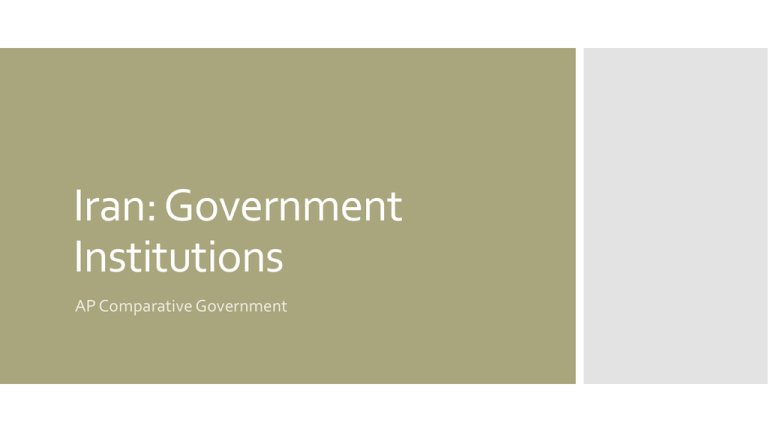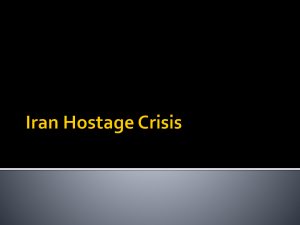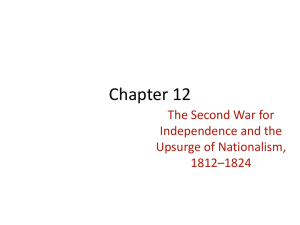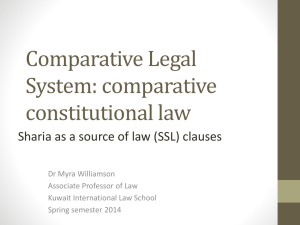File - AP Comparative Government
advertisement

Iran: Government Institutions AP Comparative Government Iran is a highly centralized unitary state General There are some provincial, district, and local governments, but they have very little power The blending of Theocratic and democratic ideas lead to a complex system of government The supreme leader, the Guardian Council, the Assembly of Religious Experts and the Expediency Council do not fit into the three-branch model of government set forth by the Iranian Constitution Jurist’s Guardianship All four agencies have broad executive, legislative, and judicial powers that allow them to supersede all other positions and bodies within the government According to Ayatollah Khomeini, each office has all-encompassing authority over the whole community based upon the understanding of the sharia and their commitment to support the rights of the people This is known as jurist’s guardianship Based upon the Constitution of 1979 (amended in 1989), Ayatollah Khomeini was given the role of Supreme Leader until his death After his death, his authority was to pass to a leadership council of two or three senior clerics The Supreme Leader This did not happen and Ali Khamenei was appointed for life to be the Supreme Leader of Iran The Supreme Leader is given many powers He is the faqih: The Islamic jurist who is to interpret the meaning of religious documents and sharia He links the three branches of government together He is also to determine the interests of Islam Powers of the Supreme Leader include: Supreme Leader Elimination of presidential candidates Dismissal of the president Command of the armed forces Declaration of war and peace Appointment and removal of major administrators and judges Nomination of six members of the Guardian Council Appointment of non-governmental directors Radio-televisions, semi-public foundations The Supreme leader holds ultimate power in the government This is despite being considered only the head of state This Guardian Council represents the theocratic principles of Iran The Council is made up of twelve male clerics Guardian Council 6 members are appointed directly by the Supreme Leader and the final 6 members are appointed by the chief judge and confirmed by the Majles It is the job of the council to verify that laws passed by the Majles conform to sharia law They also have the power to determine who can run in elections Along with the supreme leader the Council exercises the principle of jurist’s guardianship This is the enforcement of Islamic beliefs and laws amongst all democratic bodies The Assembly is directly elected by the people every four years and is composed of 86 men The Assembly of Religious Experts They have the power, along with the Council and Supreme Leader, to interpret the Constitution The Assembly was responsible for electing Ali Khamenei as Supreme Leader They also gave themselves the authority to dismiss Khamenei if he did not fill the shoes of Khomeini All members are subject to approval by the Guardian Council It was once required that all members have a seminary degree Opposition leader Hashemi Rafsanjani was picked as the leader of the Assembly in 2007, but was forced to step down in 2011 The Expediency Council The Expediency Council was designed by Khomeini to mediate disputes between the Majles and the Guardian Council It currently has 32 members and now has the power to originate its own legislation All members are appointed by the Supreme Leader Members of the Expediency Council are largely considered to be the most powerful men in the country The president of Iran does not have the same authorities the U.S., Mexico, and Nigeria The Executive The president is the highest elected office and functions as the head of government The president is elected every four years by Iranian citizens The president is limited to two consecutive terms in office The president of Iran is still required to be a pious Shiite who upholds Islamic principles Presidential powers include: The Executive Devising the budget Supervising economic matters Proposing legislation to the Majles Executing policies Signing of treaties, laws, and agreements Chairing the National Security Council Selecting vice presidents and cabinet ministers Appointing provincial governors, town mayors, and ambassadors The cabinet conducts the real work governing the people Almost all new laws and budget are put together by the cabinet The Executive Ahmadinejad and Khameni generally supported each other but at the end of Ahmadinejad’s presidency, the to had started to compete with each other They rarely disagreed on policy, but they struggled to distinguish who has the most authority to run the government The bureaucracy has doubled since 1979 and is dominated by religious interests The ministries of Intelligence, Interior, Justice, and Cultural and Islamic Guidance are run by clerics and other posts are dominated by their relatives Bureaucracy/S emipublic Institutions Semipublic Institutions are theoretically autonomous but they are directed and appoints personally picked by the Supreme Leader They are tax exempt and generate a large portion of income for the government Because the companies are run by those with such strong ties to the government, they are often referred to as para-statals, or bonyads These organizations are plagued by inefficiency and corruption and are widely criticized for unfairly competing with private companies The Majles is a unicameral legislature The Majles has significant powers that allow them to: The Legislature (The Majles) Enact or change laws (with the approval of the Guardian Council) Interpreting legislation, as long as they do not contradict judicial authorities Appointing six of the twelve members of the Guardian Council, chosen from a list presented by the chief judge Investigating the cabinet ministers and public complaints against the executive and judiciary Removing cabinet members, but not the president Approving the budget, cabinet appointments, treaties, and loans The Majles has 290 seats and all are directly elected through single members districts The judiciary is headed by a chief justice with an understanding of sharia (which means he is a cleric) The Judiciary The chief justice is appointed by the supreme leader for a five year term He is also responsible for managing the judiciary and overseeing the appointment and removal of judges The Supreme Court is beneath the chief justice but is the highest court of appeals All justices are high-ranking clerics who are familiar with sharia There are two types of law in Iran sharia and qanun In all cases the Guardian Council has the final say in the interpretation of law Sharia law (Islamic law) The Judiciary This is the foundation for all Islamic civilization and its authority is supposed to go beyond Iran’s borders These rules are supposed to be the essence of Muhammad himself Sharia is meant to embody a vision of a community in which all Muslims are brothers and sisters and subscribe to the same moral values In Iran the idea of sharia is supposed to supersede all other law and it is the job of all politicians to support sharia Qanun There is no sacred basis with Qanun Qanun are laws passed by the Majles and can not contradict sharia While judicial review does exist in Iran, it is to uphold sharia not the constitution The Sharia is interpreted very strictly The Judiciary Demanding blood money is legal and the death penalty is used to punish offenses like adultery, homosexuality, drug dealing, and alcoholism It also sets up unequal treatment between men and women, and Muslims and non-Muslims The Revolutionary Guards were established after the 1979 Revolution The Military The Revolutionary Guards were designed to stop the military from trying to take over the government and are commanded by the supreme leader The regular army is supposed to defend the borders while the Revolutionary Guards protect the republic











